Pentasodium DTPA, Diethylenetriaminepentaacetic Acid Pentasodium
Properties:
Diethylenetriaminepentaacetic acid pentasodium salt is an organic chelating agent. IRO Chelating manufactures and distributes fine chemicals with the quality you can count on.
These chelating agents include CAS number 140-01-2. Whether you call it Diethylenetriaminepentaacetic Acid Pentasodium Salt or Pentasodium Pentetate, you can be assured of IRO's products. They all meet or exceed the grade requirements or specifications for each product.
CAS No.: 140-01-2
EINECS: 205-391-3
Molecular Formula: C14H18N3O10Na5
Molecular Weight: 503.26
Structural Formula:

Specification:
| Item | Index |
| Appearance | Light yellow liquid |
| Assay, % | 40 Min. |
| Colority: (APHA) | 250 Max. |
| Specific gravity | 1.3 |
| Bulk density, kg/m3 | 1300 |
| pH Value (1% of the solution) | 11.0~12.0 |
| Chelated value, mg CaCO3/g | 80 |
Applications:
Diethylenetriaminepentaacetic acid pentasodium salt is also made use of in soaps as a water softener. And also to prevent dyes and perfumes from integrating with metal ions in solution.
Diethylenetriaminepentaacetic acid pentasodium salt water solution service may be utilized in a competitive indirect enzyme-linked immunoassay. For the quantitative measurement of lead ions. Engineers also use it in the one-step immunochromatographic assay (ICA). For the fast detection of lead ions in water samples.
In the pulp sector as a stabilizer in peroxide as well as hydrosulphite bleaching. In the fabric field as a stabilizer in bleaching and also coloring baths. In the photographic sector as a stabilizer in developing baths.
Synthesis Method:
The invention discloses a synthesis method of a DTPA (diethylene triamine pentacetic acid) penta-sodium salt. And it belongs to the field of chemical synthesis.
The synthesis method comprises the following steps. 1. Dissolving chloroacetic acid into deionized water to obtain a chloroacetic acid solution. 2. Adding diethylene triamine into the chloroacetic acid solution for reaction, and maintaining the temperature of a solution reaction system at -20-30℃. 3. Slowly add 2/5 to 3/5 of sodium hydroxide into the solution reaction system, controlling the reaction temperature at -20-30℃. 4. Slowly adding the remaining sodium hydroxide into the reaction system, and controlling the reaction temperature at 30-60℃, and preserving heat and reacting for 2-5 hours after the sodium hydroxide is completely added; And then adjust the pH of the reaction system in the step 4) to 11.5. cooling to room temperature, and filtering.
According to the synthesis method, the yield of the DTPA penta-sodium salt is improved; in the synthesis process, the reaction is relatively stable and the reaction time is shortened by controlling the alkali dripping speed and the reaction temperature. (Click here for more details)
Packing and storage:
250kg in polyethylene drum or IBC drum store in a cool, dry place. Store in a tightly-closed container.
Synonyms:
Pentasodium DTPA, 140-01-2, PENTASODIUM PENTETATE, Tetralon B, Trilon C, Versenex 80, Diethylenetriaminepentaacetic acid pentasodium salt, Hamp-ex 80, Detarex py, Kiresuto P, Chelest P, Plexene D, Syntron C, Chel 330, Pentasodium diethylenetriaminepentaacetate, Perma kleer 140, Dtpa pentasodium salt, Clewat DP 80, Caswell No. 642B, UNII-961TOZ5L7T, HSDB 5629, Sodium diethylenetriaminepentaacetate, EINECS 205-391-3, EPA Pesticide Chemical Code 039120, 961TOZ5L7T, N N-Bis(2-(bis(carboxymethyl)amino)ethyl)glycine pentasodium salt, Pentasodium(carboxylatomethyl)iminobis(ethylenenitrilo)tetraacetate, DIETHYLENETRIAMINEPENTAACETICACIDPENTASODIUMSALT, DTPA NA5, EC 205-391-3, C14H18N3Na5O10, DTXSID9027077, LQPLDXQVILYOOL-UHFFFAOYSA-I, AKOS015914109, Pentasodium DTPA.
-
EDTA Series
- EDTA Acid
- EDTA-Na2
- EDTA-Na4
- EDTA-CaNa2
- READ MORE...
-
Organophosphoric
- ATMP
- BHMTPMPA
- DTPMPA
- EDTMPA
- HEDP
- READ MORE...
-
Other Chelating Agent
- DTPA
- NTA.Na3
- DTPA.Na5
- READ MORE...


